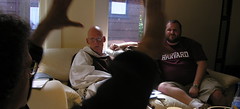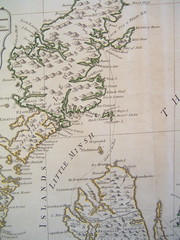Deracination: A Short History
In Latin, a Radix is like a radish, meaning it's a root. Trees and people both have them. People, like trees, are deracinated by the coming of civil engineers, bulldozers, and rent hikes, and the deracinated people of modernity lose their connection to neighborhood, history, and nature.
This is the story of the deracination of people from their territory. Deracination is not necessarily modern; Mongol hordes and Persian armies caused the flight of peasants from their land. Slaves and serfs were owned by the land, not owners of it.
What they did have was the power to build and to name. In the modern era, individuals lost that control, living in an increasingly artificial environment where the very city around them was planned by experts removed in a high tower from the people whose lives they ordered.
In the modern era, the promise of control over one’s own territory became one of the signature promises of liberalism and the modern state. For landholders, security of property became, through the English Civil War, among the key promises by the state that guaranteed the self-determination of the individual from interference by neighbor or government. But the promises of control over territory went further than that. Nation-states, policing far-off military borders, exempted residents in the middle of the country from the risk of ever having their village burned down by an invading enemy.
Moreover, modern governments worked to improve the value of property, enriching the security of landholders and occasionally even extending membership in the class of landlords into the wider public. In India and Egypt and Africa, colonizing western powers divided land that had never been privately owned, planning immense irrigation projects and settling the peasantry with secure property rights. Infrastructure projects like the government oversight of agriculture after the Dust Bowl promised to increase the security of farmers such that another mass migration from valueless land would never be necessary again. After the Second World War, the government of the United States generalized the principle of landholding to the majority of the middle class through the government backing of mortgages designed to create an unprecedented class of landholders, secured in their property rights against economic catastrophe.
Improvement and reform enriched an elite few. They placed the majority, however, in a situation of greater and greater uncertainty. Eminent domain rulings tore down the houses of the poor to make way for infrastructure. Public housing blocks housed the poor in structures whose designs and rules were controlled by persons other than the residents. Dams that improved agriculture in certain areas exhausted the resources in others. From generation to generation, the power to control territory – to design the rivers, to take property, to order the parks and sidewalks and what could be done there, to promote one region’s economy or not – was consolidated in the hands of a class of expert managers, civil engineers, urban planners and architects.
-
This is hardly the only story about the lack of control by the poor over their own destiny. In the consolidation of modern political parties in the nineteenth century, the working poor lost much of the power they once had to shape the political messages carried forward by protests on the street, even as they won the vote. Free-market policies that promised to distribute wealth impoverished Ireland. The devaluation of currency in India and the lack of political control over their own destiny kept that nation impoverished and subject to famine so long as it remained a colony. Marxism theorizes fundamental categorical differences in the composition of society based on relationships to labor such that in a system of capitalism, industrial and bourgeois interests flourish at the expense of the proletariat, excluding the poor from the privileged organs of education and media by which society is directed. Theories of race conjecture that modern Europeans favored differentiation by skin color above even categories of labor, creating a permanent underclass based in the global south responsible for labor and excluded from the privilege of directing society.
Power over territory looks to other organs than education and media. It asks what became of the public square and the public protest, about how it is that marches in the street, so powerful in eighteenth-century Europe, became in the twentieth century a permanent carnival of the dispossessed with limited power to change public opinion.
How power over territory might look different than other kinds of power became the subject of social theory beginning in the 1830s. Radicals from the Chartist movement, complaining about their lack of political power, foregrounded the significance of territory as a means of accessing political, economic, and social power, encouraging working-class persons to plot and invest in villages where ownership of cheap property would provide economic security, political self-governance, and social interaction. From the 1840s to the 1910s, radicals and philanthropists equally lobbied for the creation of allotment gardens that would supply the working poor with the means of self-sufficiency by granting them reserves of land in the midst of industrial areas. By the 1860s, the various iterations of the land reform campaign raised a plea for the division of large estates and farms, imagining a Britain refashioned into a nation of prosperous smallholders where the multitude, not the few, could weigh into questions about the design of infrastructure and cities.
Other theorists focused on the social and cultural aspects of control over territory. In Town Swamps and Social Bridges, Godwin argued that the problem of geographical isolation between the classes generated further problems of mutual ignorance. Social spaces for mutual interaction were contrived. In the 1880s, theorists of community pointed to the loss of open spaces for everyday interaction, drawing attention to the significance of arenas for informal interaction for building social and ethical discourse.
Still others imagined campaigns to restore political control over territory to the poor. In the 1930s, campaigns for the mapping of territory sought to empower the working poor to advise parliamentary committees with the same power to convince as that of expert elites.
Labels: deracination, landscape, place, roots











2 Comments:
My Armenian host uncle, a respectable and educated physics teacher, sat me down and explained to me that there were seven races in the world:
The Armenians, the Persians, the Russians/Europeans, the Chinese, the Africans, the Indians and the Jews.
I tried explaining to him the different races we have in America, but got bogged down on the schizophrenia of whether or not "Hispanic" constitutes a race.
It was just a good reminder that race is a social construct, and a particularly local one. An outsider would have a great deal of trouble distinguishing an Abkahzian from an Ossetian from a Georgian, but it's a matter of great importance for residents of the Southern Caucasus. Millions of disenfranchised individuals across the world are quite happy to take up arms to kill those who trespass on the lands to which they have a racial claim, and to form individual self-regulated militias to enforce it. It's probably one of the oldest human instincts.
Reminds me of the Kreyol "dechoukaj" that I learned from Amy Wilentz' writings on Haiti. Similar 'uprooting' meaning, although seemed more to be against those with power/overturning the established order. (http://hnn.us/node/123053).
Super relevant for the folks I know who tried to put down roots in Grant Park yesterday - and how that relates to the uprooting that's happened to others in Chicago.
Post a Comment
<< Home